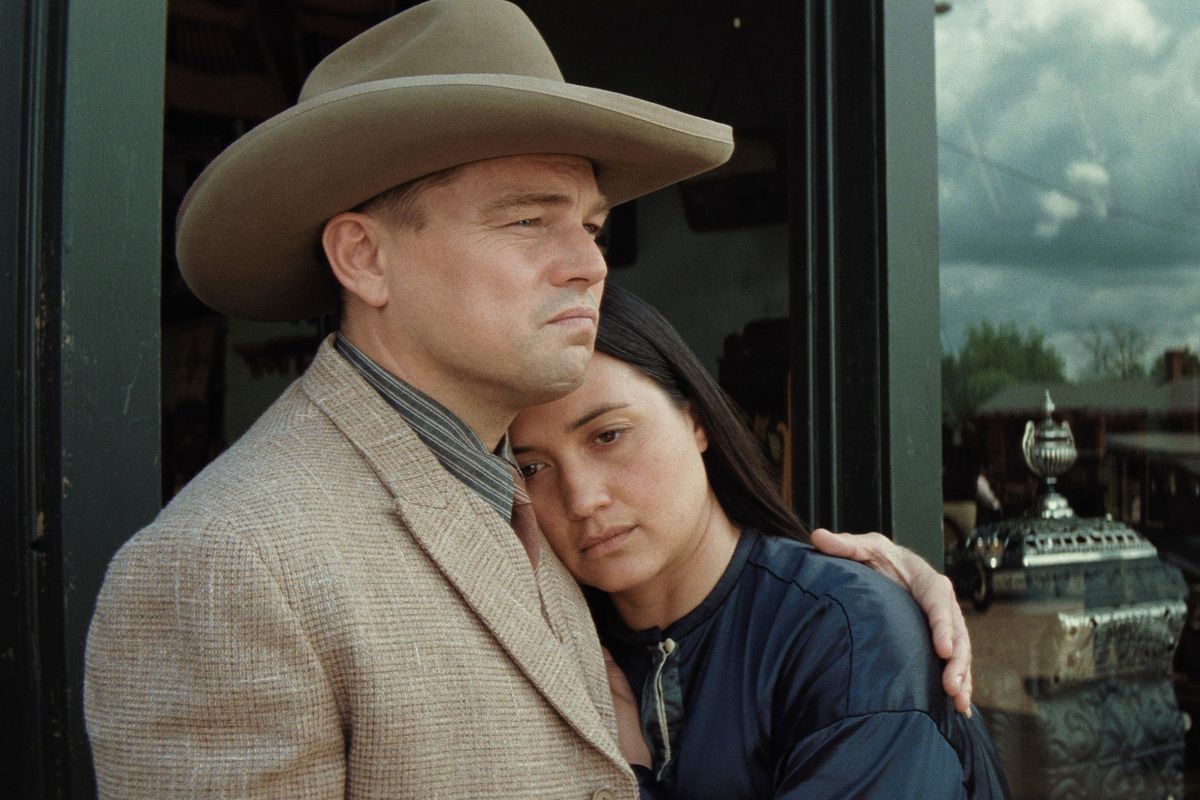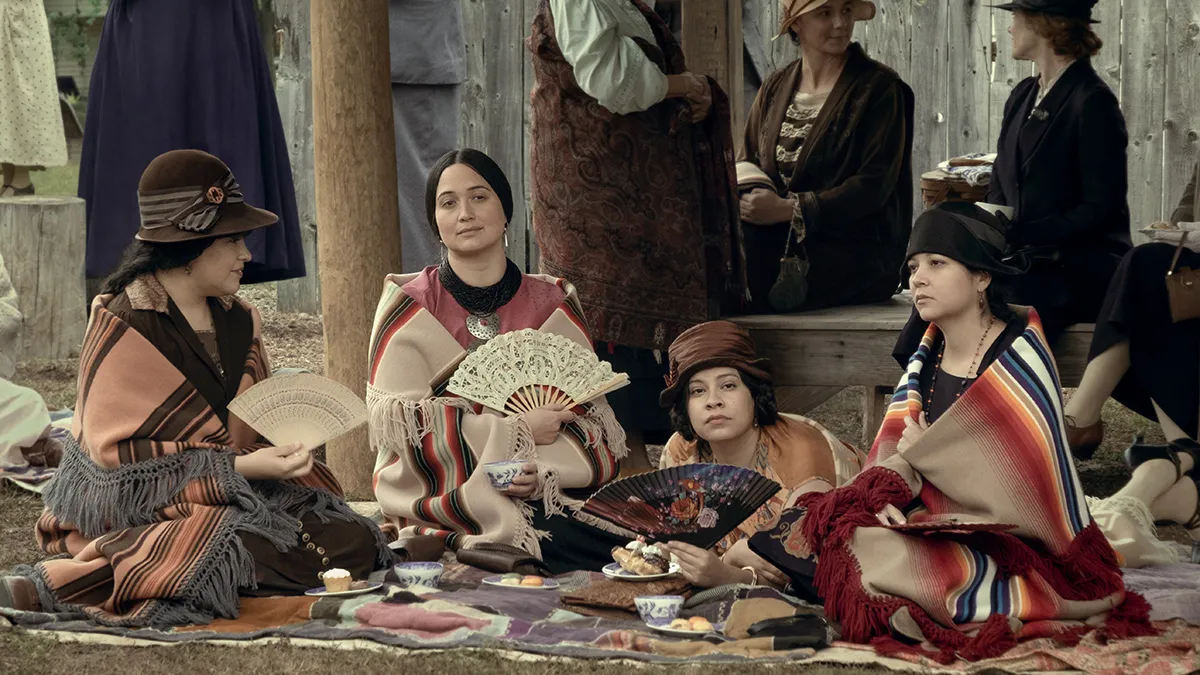Previously, we discussed some of the struggles depicted in Killers of the Flower Moon, like MMIWG2S and deaths of despair, that remain major issues in the present for many Native American communities. In part two, we’re exploring other issues represented in the film, including racism in medicine, malnourishment, and diabetes.
Spoilers ahead for Killers of the Flower Moon
Another major connection to ongoing issues faced by Native Americans today is the abuses by those in healthcare and the prevalence of diabetes. Even leaving out the experiments done in the name of science to prove racial inferiority, medical abuse runs rampant in Killers of the Flower Moon. In the film, Scorsese shows how, with a doctor’s help, Ernest Burkhart (Leonardo DiCaprio) and his family slowly poisoned Mollie (Lily Gladstone) to steal her family’s oil headright. The abuse-framed-as-help that happened to Mollie is not an outlier. Infamously, blankets contaminated with smallpox were distributed to Native American nations of the Great Lakes region by the British during colonial rule. However, in the 20th century this violence continued.
During an outbreak of trachoma (a dangerous eye infection) in the 1920s, the precursor to the Indian Health Services (IHS) performed experimental eyelid-removal procedures on Native Americans who caught the disease. Then, in the ’50s, the U.S. Air Force gave radioactive iodine to Alaskan Natives of all ages in a community with many non-English speakers. Much of this mistreatment overlaps with the failure to get informed consent—a patient’s consent to receiving treatment after being informed of the known inherent risks. Conversations regarding informed consent didn’t start becoming commonplace until after the Holocaust. Still, the practice didn’t become standardized until 1972. Unconscious biases and active racism led to exceptions being made for marginalized people like Native Americans for decades.
Medical racism and mistrust from the 1970s forward
The same decade that informed consent became standard practice, malpractice continued in an alcohol study with Inupiat teens. Then, in the ’90s, Arizona State University mishandled Havasupai blood samples for a diabetes trial. This ASU mistreatment caused extended grief as Havasupai cultural beliefs dictated that all parts of the body need to be together for the spirit to pass into the afterlife. These are just a few very high-profile examples that have been extensively documented.
While Mollie doesn’t face issues of reproductive injustice in Killers of the Flower Moon, many women like her did. Throughout the 20th century, the federal government used pseudo-scientific eugenics-oriented programs to “tackle” poverty and public health. Sociologist Dorothy Roberts found that between 1907 and 1970, the U.S. government sterilized over 70,000 women—mostly women of color—by coercion or without their knowledge. At one point, U.S. physicians sterilized over 50% of Puerto Rican women. With patients as young as 15, one physician sterilized 3,000 women across four IHS hospitals between 1973 and 1976. They noted:
[a]ll the pureblood women of the Kaw tribe of Oklahoma have now been sterilized. At the end of the generation the tribe will cease to exist.
These events and more contributed to the sustained issue of very understandable mistrust of U.S. health services among POC. Currently, culturally competent care programs and unconscious bias training are ways some in the medical field are trying to rebuild trust. Those experiencing poverty and living in certain rural areas (like Mollie) depend on a very underfunded IHS. Additionally, individual moments of discrimination aren’t always documented through formal complaints or investigations. According to a 2017 NPR poll, Native Americans experience discrimination more often when they are in the majority than when they are in the minority. The questions asked were related to housing, policing, employment and voting. However, many Native Americans feel the same regarding healthcare.
Malnourishment
The conditions that led to Mollie’s diabetes diagnosis offer another connection to the present and ongoing colonization. The doctors paternalistically blame her choosing to eat “white man’s food.” Experts have linked forced resettlement to the rise in issues like diabetes, hypertension, and other health concerns among Native Americans. No longer able to produce (or hunt) food forced dependence on the U.S. government, and Indigenous diets dramatically changed. Due to high poverty rates, today over 20% of Native Americans depend on direct federal food aid programs.
Before the heavily processed commodities of the 1970s and beyond, many Native Americans who were not starving survived off of government-owed ration tickets. In exchange, people were given heavily processed, foreign (to them) ingredients. Multiple accounts report shipped food that was expired, about to expire, or rotten. Later, the “commodities” became even more calorically-dense and less nutritious, and processed to the point where almost everything was canned or frozen. From the late ’90s to the present, there has been a big push in tribal activism to gain autonomy in choosing which foods are shipped to warehouses for distribution. Coalitions between tribes advocated for more game meats and fresh foods. Much of these wins have hinged on short-term contracts, like the 2023 Farm Bill passed by Congress.
By the time more Indigenous people gained access to traditional, fresh ingredients again, the processed foods maintained a cultural foothold. Like Black Americans’ experience with slavery, Native Americans did the best they could in a terrible situation. New dishes emerged out of the limited ingredients influenced by the converging cultures, as tribes were forced together on new land. Even as more nutritious foods have started to become more accessible in the last two decades, it’s been a slow transition to centering those ingredients and dishes in regular life.
Diabetes among Native Americans

During Mollie’s lifetime, diabetes was rare among Native Americans, including the Osage. However, its inclusion in Killers of the Flower Moon does reflect a major struggle for many Indigenous communities in the present. So, the historically accurate representation functions more as a prelude rather than a reality of that time for most Native Americans. While diabetes diagnosis rates range from 5.5 – 33.5% depending on the tribe, Native Americans have the highest rate of diabetes in the country. The CDC found Indigenous pre-teens and teens with Type 2 diabetes at a rate of nine times that of white children.
Ethnologist Margaret Pollak explained to Slate that poverty pushes people to overeat because they don’t know when they might get their next meal. This learned, survival-based behavior passes from one generation to the next. People get diabetes for a variety of reasons, with diet being a small part of it. However, the aforementioned lack of access to fresh, nutritious food and preventative healthcare exacerbates metabolic and cardiovascular diseases.
Killers of the Flower Moon isn’t the first film set in the not-too-distant past to touch on these topics in a way deemed authentic to Indigenous peoples across the Americas. Indigenous people star, direct, write, and produce these stories all the time. Movies like The Transcenders, Roma, Four Sheets to the Wind, and The Body Remembers When the World Broke Open come to mind. As does television like Reservation Dogs and Dark Winds. It’s worth bringing up here because, as a major film from a revered director with a large platform, Killers of the Flower Moon will be how many people learn about these topics in a nuanced way—and one that doesn’t coddle its audience.
This is part of a series on Killers of the Flower Moon and the real-life struggles of Native Americans. Read part one here.
(featured image: Paramount Pictures / Apple Original Films)










Published: Nov 17, 2023 04:14 pm